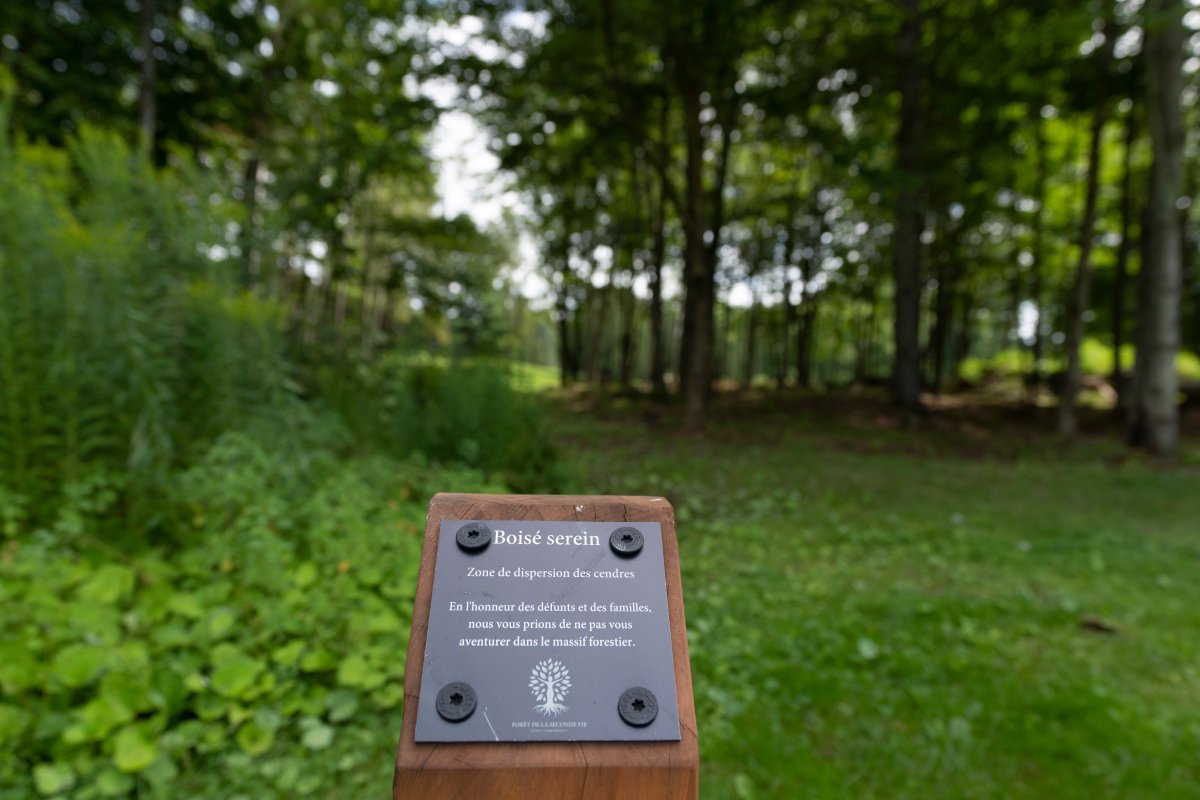At a new ecological cemetery north of Montreal there are no gravestones or plaques. Instead, people locate burial sites with the help of a cellphone app.

Cemetery Forêt de la Seconde Vie opened in Ste-Sophie, Que., on Aug. 7 with the goal of transforming a 232,000-square-metre ex-golf course into a dense forest. It plants trees along the former fairways and greens to mark the burial sites of cremated remains, a process it calls “planting roots.”
Visitors can use the cemetery’s application to find their loved one’s tree. Once there, they’re asked to scan the surrounding landscape with their cellphone camera until a virtual chest pops up on screen, revealing digital memorabilia within: photos, videos and even recipes belonging to the deceased.

The cemetery claims to be the first in North America to be an official forest producer, a certification that in Quebec involves consulting a registered forest engineer to develop a land management plan.
For Mylene Hebert, 27, the concept was a welcome alternative to a traditional burial for her father, a longtime resident of Ste-Sophie who died in 2021 at the age of 55. She rejected the idea of a graveyard interment, which she called “gloomy” and “negative,” and she said she was immediately drawn to Forêt de la Seconde Vie when she heard about it. She plans to plant his tree on Oct 1.
“I think it’s incredible,” she said in a phone interview. “With paper photos, we can lose them,” but with the cemetery app, “they will be recorded when we go visit … I can’t wait to see how it’s going to look in 20 years, 30 years, 40 years.”
In 2019, co-founders Ritchie Deraiche and Guillaume Marcoux bought the property that would become Forêt de la Seconde Vie. Both fathers of young children, they said they came up with the idea while reflecting on how to combine environmental stewardship with family legacy.
“We wondered what concrete difference we could actually make right now in terms of preserving the environment, preserving and creating an ecosystem, biodiversity, and then, what we can leave to the generations that follow us,” Marcoux said in a recent interview.
The endeavour was especially personal for Deraiche. In June, his grandmother became the first person to have their ashes buried under a new tree on the site.
The founders hope their clients develop a similar, personal connection to the cemetery. Its very design is supposed to facilitate an emotional attachment to the land, allowing visitors to “immerse themselves in the forest and create a sense of belonging,” Marcoux said.
An online map advertises five thematic zones — with names like the Woods of Sighs and the Nourishing Forest — each with five tree species from which customers can choose.
Though there’s little to observe so far, around 20 spindly saplings — the first of 7,000 planned trees — stand as testaments to the cemetery’s first clients. Elsewhere, wooden stakes poke out of expansive golf fairways to delineate future planting sites.
But there are other points of interest, including swings, a hammock and a large sculpture of outstretched fingers emerging from the Earth. These opportunities for amusement distinguish Forêt de la Seconde Vie from traditional, solemn burial grounds and foster visitors’ bond with the property, Fannie Tremblay, its administrative director, said during a site visit.
The cemetery further achieves this by encouraging the living to invest — both financially and emotionally — in their own trees before their death. Tremblay is among them, with a fledgling oak tree in her name in the cemetery’s northwest corner.
An 18-square-metre plot with a memorial tree and virtual chest starts at $3,750, according to the company website. At $14,999, the most expensive Forêt de la Seconde Vie package includes an additional 55 square metres and burial rights for the ashes of as many as eight other people.
The customizable tributes at Forêt de la Seconde Vie are part of a “major cultural shift” in attitudes about funerals in North America, explained Tanya Marsh, a law professor at Wake Forest University, in North Carolina, who studies the treatment of human remains.
Two trends are driving that shift, she said in a recent interview. The first, she noted, is “a greater interest in memorialization options and personalization,” in contrast to the “prepackaged services and goods” one might find at a funeral home.
The second is what Marsh called an “increased interest in greening the funeral.” She pointed to the rapidly growing popularity of cremation, a practice that consumes fuel but, she said, may be seen as more environmentally friendly than embalming and burial in coffins.
Cremation Association of North America data show the five-year average cremation rate was 57.5 per cent in the U.S. and 74.8 per cent in Canada in 2021, compared to 33.8 per cent and 55.8 per cent, respectively, in 2006.
Marsh expects alternative funeral practices to become more common in the years ahead.
“Death is the ultimate human problem. And we’re always gonna have to deal with it,” she said. “And so people are just gonna continue innovating and coming up with these new and interesting ways ? (to) help us process grief.”
“So it’s an exciting time to be interested in death.”



Comments